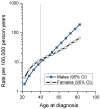Divergent cancer pathways for early-onset and late-onset cutaneous malignant melanoma
- PMID: 19536874
- PMCID: PMC2741537
- DOI: 10.1002/cncr.24481
Divergent cancer pathways for early-onset and late-onset cutaneous malignant melanoma
Abstract
Background: Emerging data suggest that cutaneous malignant melanomas (CMM) may arise through divergent cancer pathways that are linked to intermittent versus accumulated sun exposure. However, numerous questions remain regarding the timing and/or age of exposure.
Methods: The authors systematically examined the effect of aging on CMM incidence in data from the Surveillance, Epidemiology, and End Results Program of the National Cancer Institute. Standard descriptive epidemiology was supplemented with mathematical models. The impact of advancing age on CMM incidence was assessed by sex, histopathologic classification (superficial spreading melanoma [SSM] or lentigo maligna melanoma [LMM]), and anatomic site (face, head, and neck [FHN] or lower extremity [LE]).
Results: Sex, histopathology, and anatomic site were age-specific effect modifiers for CMM that indicated divergent (bimodal) early-onset and late-onset cancer pathways. Early-onset melanomas were associated predominantly with women, SSM, and LE. Late-onset melanomas were correlated with men, LMM, and FHN. Early- and late-onset melanoma populations were confirmed with age-period-cohort models that were adjusted for period and cohort effects. Two-component mixture models also fit the data better than a single cancer population.
Conclusions: The current results were consistent with a divergent and age-dependent solar hypothesis for CMM. Early-onset melanomas may represent gene-sun exposure interactions that occur early (and/or intermittently) in life among susceptible individuals. Late-onset melanomas may reflect accumulated, lifelong sun exposure in comparatively less susceptible individuals. Future analytical studies should be powered adequately to account for this age-dependent effect modification both for acknowledged melanoma risk factors (sex, histopathology, and anatomic site) and for suspected melanoma risk factors, such as constituent genetic variants.
Figures



Comment in
-
Divergent cancer pathways for early onset and late onset cutaneous malignant melanoma: a role for sex-site interaction.Cancer. 2010 May 15;116(10):2499; author reply 2500. doi: 10.1002/cncr.24985. Cancer. 2010. PMID: 20225335 No abstract available.
References
-
- Curtin JA, Busam K, Pinkel D, Bastian BC. Somatic activation of KIT in distinct subtypes of melanoma. J Clin Oncol. 2006;24(26):4340–6. - PubMed
-
- Fecher LA, Cummings SD, Keefe MJ, Alani RM. Toward a molecular classification of melanoma. J Clin Oncol. 2007;25(12):1606–20. - PubMed
-
- Elwood JM, Lee JA, Walter SD, Mo T, Green AE. Relationship of melanoma and other skin cancer mortality to latitude and ultraviolet radiation in the United States and Canada. Int J Epidemiol. 1974;3(4):325–32. - PubMed
-
- Mack TM, Floderus B. Malignant melanoma risk by nativity, place of residence at diagnosis, and age at migration. Cancer Causes Control. 1991;2(6):401–11. - PubMed
-
- Elwood JM, Jopson J. Melanoma and sun exposure: an overview of published studies. Int J Cancer. 1997;73(2):198–203. - PubMed
Publication types
MeSH terms
Grants and funding
LinkOut - more resources
Full Text Sources
Medical

